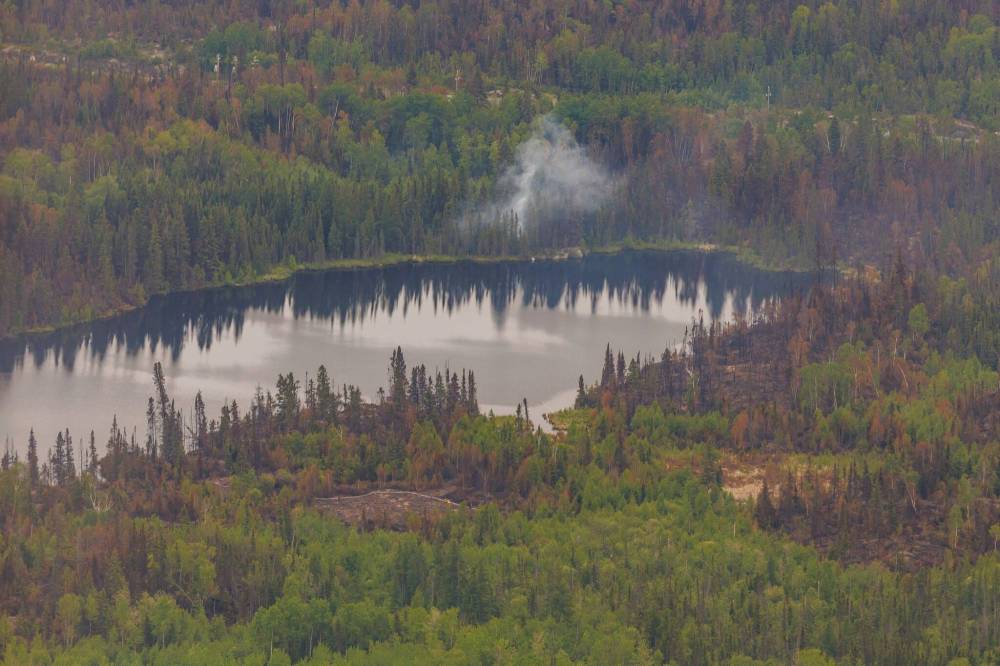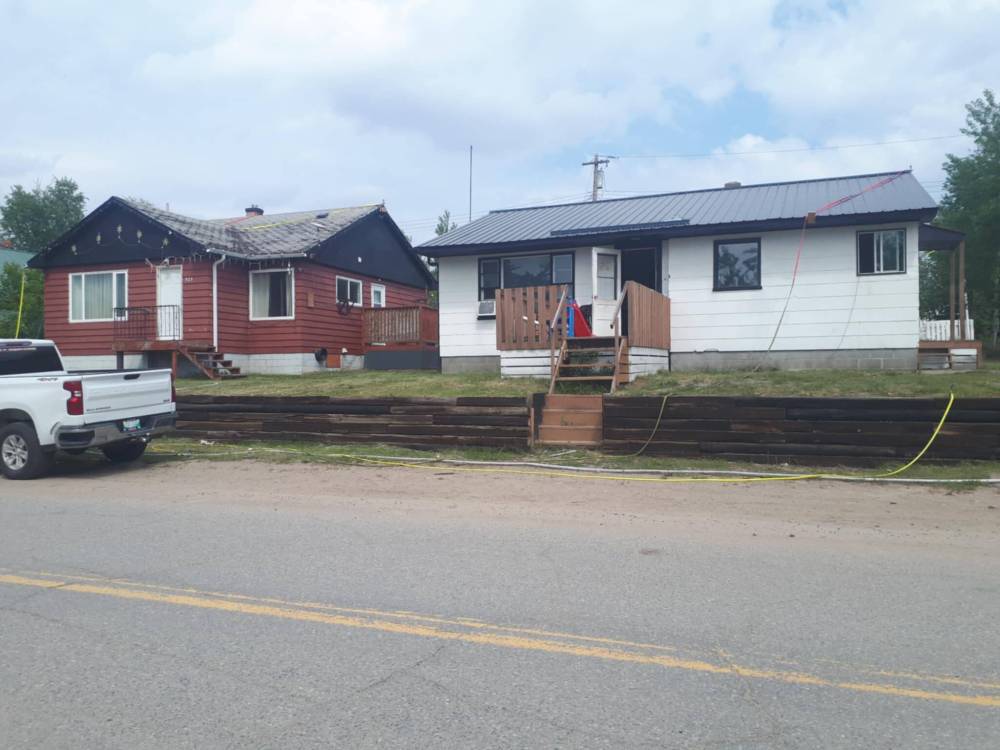Manitoba to lift travel, burn restrictions Friday
Read this article for free:
or
Already have an account? Log in here »
To continue reading, please subscribe:
Monthly Digital Subscription
$0 for the first 4 weeks*
- Enjoy unlimited reading on winnipegfreepress.com
- Read the E-Edition, our digital replica newspaper
- Access News Break, our award-winning app
- Play interactive puzzles
*No charge for 4 weeks then price increases to the regular rate of $19.00 plus GST every four weeks. Offer available to new and qualified returning subscribers only. Cancel any time.
Monthly Digital Subscription
$4.75/week*
- Enjoy unlimited reading on winnipegfreepress.com
- Read the E-Edition, our digital replica newspaper
- Access News Break, our award-winning app
- Play interactive puzzles
*Billed as $19 plus GST every four weeks. Cancel any time.
To continue reading, please subscribe:
Add Free Press access to your Brandon Sun subscription for only an additional
$1 for the first 4 weeks*
*Your next subscription payment will increase by $1.00 and you will be charged $16.99 plus GST for four weeks. After four weeks, your payment will increase to $23.99 plus GST every four weeks.
Read unlimited articles for free today:
or
Already have an account? Log in here »
The Manitoba government will lift its fire and backcountry travel and camping restrictions at 8 a.m. Friday after recent rainfall lowered wildfire danger in many parts of the province.
Some municipalities still have restrictions that apply to off-road vehicle use, open fires or fireworks within their boundaries ahead of what is anticipated to be a busy weekend and Canada Day.
“We want Manitobans to be able to settle in, and have a nice long weekend and enjoy Manitoba’s nature, but we’re asking people to do that responsibly, and just be mindful of the environment around them,” Christine Stevens, assistant deputy minister of the Manitoba Emergency Management Organization, told reporters.
Backcountry travel within the boundaries of an active fire will be restricted unless a permit is obtained, said Kristin Hayward, assistant deputy minister of the Manitoba Wildfire Service.
Provincial restrictions across much of northern and eastern Manitoba, where fires have mostly occurred this year, mainly applied to backcountry hiking and camping, off-road vehicle use and campfires.
“Now that the fire danger has reduced, there’s less of a chance that those types of activities might result in the start of a new fire, and we’ve deemed that it’s relatively safe for people to access many areas that previously might have been threatened by an active fire,” Hayward said.
Fireworks are not permitted in any provincial park, she said.
MIKE DEAL / FREE PRESS FILES Many remaining fire and travel bans are being lifted in much of northern and eastern Manitoba after recent rainfall.
The changes were made after Manitoba ended a provincewide state of emergency Monday. Manitobans were advised to check whether local restrictions exist, or visit the Manitoba Parks website before heading to a provincial park.
The Mantario wilderness area in Whiteshell Provincial Park is closed.
Hayward said the 63-kilometre Mantario Trail is closed “indefinitely” until it can be assessed, and Manitoba Parks “has an opportunity to make sure that it’s safe for people to go there, and they know what kind of condition the trail is in.”
Six of 18 active fires in the province were considered out of control Thursday. Rainfall in key areas, including Flin Flon, The Pas and eastern Manitoba, helped crews make “really good progress” and prevent significant growth, Hayward said.
Wildfire update
The Manitoba Wildfire Service said there were 18 active wildfires across Manitoba as of Thursday afternoon.
Six fires were considered out of control.
The province has recorded 131 wildfires so far this year. The 20-year average for June 26 is 143 fires.
The Manitoba Wildfire Service said there were 18 active wildfires across Manitoba as of Thursday afternoon.
Six fires were considered out of control.
The province has recorded 131 wildfires so far this year. The 20-year average for June 26 is 143 fires.
The total area burned so far in 2025 is more than 900,000 hectares.
These are among the fires of concern in Manitoba.
East region Fire EA061
Status: Out of control
Size: About 226,160 hectares
The fire has affected a massive area, stretching from Bird River to remote places east of Bissett. Parts of Nopiming Provincial Park are still closed. Wallace Lake and South Atikaki provincial parks remain closed.
West region Fire WE017
Status: Out of control
Size: About 370,780 hectares
Manitoba’s largest blaze formed as several fires merged, affecting the Flin Flon and Sherridon areas, and several communities in Saskatchewan. Flin Flon’s airport at Bakers Narrows is still closed. Boaters in the region are asked to avoid waterways that are being used by Manitoba Wildfire Service water bombers and helicopters.
Fire WE025
Status: Being monitored
Size: About 55,140 hectares
The fire around Mathias Colomb Cree Nation is contained, but the community is without power and remains under a mandatory evacuation order.
Fire WE028
Status: Out of control
Size: About 7,200 hectares
The blaze is about 10 kilometres from Bakers Narrow Provincial Park.
North region Fire NO002
Status: Out of control
Size: About 71,860 hectares
The fire is located near the town of Lynn Lake, which is under an evacuation alert in case conditions worsen.
Fire NO005
Status: Out of control
Size: About 64,860 hectares
The blaze is near Pimicikamak Cree Nation, the incorporated community of Cross Lake, Jenpeg Generating Station and Whiskey Jack Landing.
Fire NO010
Status: Out of control
Size: About 21,560 hectares
Tataskweyak Cree Nation (Split Lake) remains under a mandatory evcacuation alert due to a malfunctioning water treatment plant.
The number of out-of-province firefighters and support staff dipped to 263 from 375 earlier in the week. More crews are expected to arrive soon to backfill those who’ve left, Hayward said.
Thunderstorms were expected in some places amid hopes for more rain. Lightning strikes could spark new fires. Strong wind gusts are also anticipated.
“A bit turbulent, I would say, in terms of the weather,” Hayward said. “Temperatures aren’t looking really intense. Most of the province will be in kind of a low to moderate fire danger, I would expect.”
An evacuation alert remained in effect for Lynn Lake due to a 71,860-hectare, out-of-control fire near the northwestern town. Residents were told they may have to leave on short notice if conditions worsen.
More than 900 residents of Lynn Lake and Marcel Colomb First Nation were displaced from May 27 to June 20.
Hayward said the situation was “holding fine” as of Thursday afternoon, while crews focused on hot spots.
Sprinklers were set up as a precaution outside several homes, including one belonging to Chantelle Thomas, her partner and their six children.
CHANTELLE THOMAS PHOTO Wildfire protection sprinklers were set up as a precaution at homes in Lynn Lake due to a nearby fire that could pose a risk to the town if conditions change.
“It’s pretty smoky here. It’s really windy,” Thomas said. “It’s just really stressful because you never know when you could be evacuated, but we’re prepared. We’ve got all of our bags packed.”
Thomas, 38, said her family spent 10 days in a congregate shelter in Thompson and two weeks in a hotel room after Lynn Lake was evacuated in May.
“It was very stressful, especially in the (shelter) because there were so many people there,” she said.
Provincewide, the number of evacuees has dropped from more than 22,000 to about 6,500, after Flin Flon and other communities ended mandatory evacuation orders.
Stevens said four areas are still evacuated: Tataskweyak Cree Nation (Split Lake), Mathias Colomb Cree Nation (Pukatawagan), some areas of Nopiming Provincial Park and Wallace Lake Provincial Park.
Almost 30 communities or areas were evacuated at the peak earlier this month.
The return of Tataskweyak residents was delayed due to a malfunctioning water treatment plant.
Mathias Colomb, a remote community with only air and rail access, is without power. A rail line that is used to deliver supplies to the community was affected by fire, Stevens said.
Manitoba Hydro is “mobilizing” resources to repair or replace damaged poles, lines and other equipment, both in Mathias Colomb and along a transmission line, as quickly and safely as possible, said Manitoba Hydro spokesman Peter Chura.
“This is in very rugged terrain where much of the work will require the use of helicopters to transport material and crews,” he wrote in an email. “In many places, we need to bore holes to set poles in rock. The work is expected to take several weeks to complete. We will have more exact timelines as work progresses and will ensure the community is informed.”
It took three months to fully restore power to the area after a 2022 wildfire. Generators, delivered by rail, were used in the interim.
Some evacuees from Mathias Colomb and Tataskweyak were moved to Niagara Falls, Ont., amid a lack of available hotel rooms in Manitoba. They are gradually returning to Manitoba, Stevens said.
She said about 70 evacuees were in a shelter in Sagkeeng First Nation, but hotels were available to them.
A recent Statistics Canada study suggested Manitoba’s economy is most at risk of being affected by wildfires in Canada this year.
As of mid-June, Manitoba had the largest percentage of GDP at risk, with wildfire areas, where 21,000 residents had to leave their homes, accounting for 2.4 per cent of total provincial GDP, StatCan said.
The study was based on new experimental estimates of GDP by square kilometre to measure economic activity at risk of being affected, but not necessarily being impacted, in evacuated communities, StatCan said.
Finance Minister Adrien Sala has said Manitoba will have a better idea about the cost of this wildfire season in September.
chris.kitching@freepress.mb.ca

Chris Kitching is a general assignment reporter at the Free Press. He began his newspaper career in 2001, with stops in Winnipeg, Toronto and London, England, along the way. After returning to Winnipeg, he joined the Free Press in 2021, and now covers a little bit of everything for the newspaper. Read more about Chris.
Every piece of reporting Chris produces is reviewed by an editing team before it is posted online or published in print — part of the Free Press‘s tradition, since 1872, of producing reliable independent journalism. Read more about Free Press’s history and mandate, and learn how our newsroom operates.
Our newsroom depends on a growing audience of readers to power our journalism. If you are not a paid reader, please consider becoming a subscriber.
Our newsroom depends on its audience of readers to power our journalism. Thank you for your support.
History
Updated on Thursday, June 26, 2025 5:24 PM CDT: Adds details, quotes, new photo.








